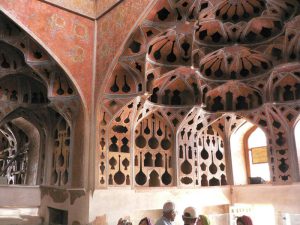نوع مقاله : مقالۀ پژوهشی
نویسندگان
- مهدی تاتاری 1
- جواد نیستانی 2
1 پژوهشگر باستانشناسی، گروه آموزشی تاریخ و باستانشناسی، دانشکده ادبیات، علوم انسانی و علوم اجتماعی، دانشگاه آزاد اسلامی واحد علوم تحقیقات، تهران، ایران.
2 استاد گروه باستانشناسی، دانشگاه تربیت مدرس، تهران، ایران.

باغ نظر (ماهنامه)
دوره 18، شماره 98
مرداد 1400
صفحه 66-55
بیان مسئله:کتیبههای کوفی در معماری اسلامی از شاهکارهای جهان اسلام و ایران به شمار میآیند. اگرچه برخی از کاروانسراهای خراسان رضوی از نظر تزیینات و معماری جزو بناهای فاخر محسوب میشوند، امّا قدمت بعضی از این بناها چندان مورد واکاوی قرار نگرفتهاند. کتیبههای بناها معمولاً یکی از شاخصترین عناصر معماری است که از زوایای مختلف یک محقق را رهنمون میشود. بنابراین لازم دانسته شد کتیبههای مورد مطالعه از جمله از نظر نگارش، اهداف و انواع خطوط مورد بررسی قرار گیرد و تأثیر آنها بر هویت بناهای مورد مطالعه مشخص شود.
هدف پژوهش: در این مقاله سعی شده است کتیبهها بهصورت مقایسة تطبیقی بررسی و کتیبههای خوانده نشده را قرائت و خوانش نادرست برخی از کتیبهها را اصلاح نماییم. بر همین اساس نگارندگان با رویکردی انتقادی نسبت به قرائت کتیبهها و با بهرهگیری از متون و اسناد باقیمانده تلاش کردند تا در بازآفرینی کتیبههای رباط ماهی و تعیین قدمت برخی از بناها پیشنهاداتی ارائه دهند.
روش پژوهش: پژوهش حاضر با روشهای پیمایشی و تاریخی تدوین شد؛ ابتدا آثار کتیبهها با بررسیهای پیمایشی دادهها ثبت و ضبط شد. سپس در رویکرد تاریخی با کار کتابخانهای، بررسی منابع دست اوّل، اسناد و مدارک عکاسان گذشته و سپس با تحلیل و طبقه بندی دادهها تلاش شد وقایع گذشته، بهطور دقیق شناسایی تا هویت تاریخی، سیاسی، اقتصادی این بناها روشنتر شوند.
نتیجهگیری: در این جستار روشن شد ساختار نگارشی کتیبههای کوفی براساس خطوط کوفی اولیه بوده و از شیوه و تنوع متعددی برخوردار هستند. همچنین هنرمندان کتیبهها در بیان پیامهای خود از عنصر تزیین بهرهگرفتهاند. قرارگیری این کتیبهها در فضاهای تعیینشده سنخیت و هماهنگی زیادی با بناهای خود دارند و از اهداف نگارش، بهرهگیری مذهبی از آنهاست. در نهایت با قرائت صحیح و بازخوانی برخی از کتیبهها، برای تاریخگذاری کاروانسراهای زیارت، ماهی و شرف پیشنهاداتی ارائه شد.
Reading, Revising and Reviewing the Kufic Inscriptions on the Caravanseries of Khorasan Razavi
نویسندگان [English]
- Mehdi Tatari 1
- Javad Neyestani 2
Problem statement: Kufic inscriptions of Islamic architecture are considered the ancient era masterpieces of Iran and the Islamic world. Some of the Caravanseries in Razavi Khorasan province are counted among superb monuments in terms of decorations and architecture. However, the antiquity of some of them has not yet been well analyzed. Monumental inscriptions are often the most outstanding architectural elements that can direct the researchers through their endeavors from various viewpoints. Therefore, we deemed it critical to review the inscriptions under the study in terms of the scripts, objectives, various calligraphy types, etc., and determine their impacts on the identity of the monuments of interest.
Research objective: This study tries to comparatively review the inscriptions, scan the obscure ones, and correct the erroneous scanning of some others. In this spirit, the authors focused their efforts on presenting advice on the recreation of the inscriptions found at Robat (a small fortification built along a frontier) Mahi excavation site. They determined some of the monuments’ ages through a critical approach toward inscriptions scanning by employing the surviving texts and shreds of evidence.
Research method: The present study was conducted through survey and archeological research methods. First, the inscriptions were recorded using the survey investigations. Then it was attempted to accurately identify the events of the past to further clarify the historical, political, and economic identities of the monuments under investigation through library research, verification of the firsthand resources, evidence gathered by the past photographers, and then through data analysis and classification, following the historical approach.
Conclusion: This study revealed that the writing structure of the Kufic inscriptions was based on the early Kufic scripts with diverse writing styles and that the artists have employed the decoration factor in conveying their message. The placement of the inscriptions in the predetermined spaces is in abundant congruity and harmony with their associated monuments. A reason for inscribing the scripts has been to serve religious purposes. Some advice was then made for age determination of Caravanseries of Ziarat, Mahi, and Sharaf sites after scanning and reading some of the inscriptions.
قرائت، بازخوانی و بررسی کتیبههای کوفی کاروانسراهای خراسان رضوی اصل مقاله 1.54 MB
صاحب امتیاز: پژوهشکده هنر، معماری و شهرسازی نظر
مدیر مسئول: دکتر سید امیر منصوری
سردبیر: دکتر احمد پوراحمد
دوره انتشار: ماهنامه
شاپا چاپی: 1735-9635
شاپا الکترونیکی: 2251-7197





















